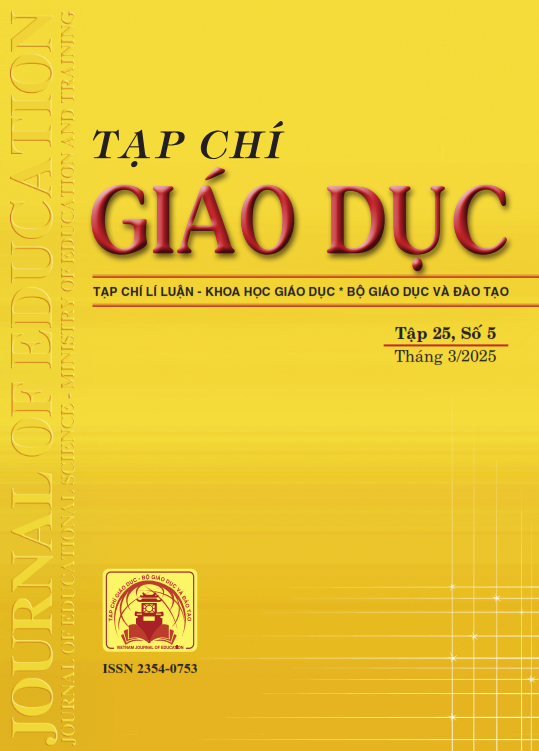Vận dụng Thuyết đa trí tuệ nhằm phát triển năng lực nhận thức và tư duy cho học sinh trong dạy học các chủ đề tích hợp môn Lịch sử và Địa lí ở trường trung học cơ sở
Tóm tắt
The flexible application of Gardner's Theory of Multiple Intelligences in teaching history in general, and teaching integrated topics of History and Geography in middle schools in particular, creates an ideal environment for students to express their abilities and strengths in the cognitive process. At the same time, it creates opportunities for teachers to flexibly apply teaching methods and means to suit students' intelligence. These days, the Theory of Multiple Intelligences has been flexibly applied in many subjects in high schools, including History. The article presents the advantages of the Theory of Multiple Intelligences; identifies the content and process; thereby proposing measures to apply the Theory of Multiple Intelligences to develop students' cognitive and thinking abilities in teaching integrated topics of History and Geography in middle schools. Ultimately, the study contributes to improving the quality of subject teaching in fulfillment of the country's education and training career. The study provides a scientific basis to help teachers effectively apply diverse teaching methods, meet students’ varied learning needs, and contribute to improving education quality and fostering comprehensive and sustainable education innovation.
Tài liệu tham khảo
Anggoro, S., Fitriati, A., Thoe, N. K., Talib, C. A., & Mareza, L. (2024). Differentiated instruction based on multiple intelligences as promising joyful and meaningful learning. International Journal of Evaluation and Research in Education, 13(2), 1194-1204.
Armstrong, T. (2011). Đa trí tuệ trong lớp học, Lê Quang Long (dịch). NXB Giáo dục Việt Nam.
Bộ GD-ĐT (2018). Chương trình giáo dục phổ thông môn Lịch sử và Địa lí (Cấp Trung học cơ sở) (ban hành kèm theo Thông tư số 32/2018/TT-BGDĐT ngày 26/12/2018 của Bộ trưởng Bộ GD-ĐT).
Campbell, L., Campbell, B., & Dickinson, D. (1996). Teaching and learning through multiple intelligences. Tucson, AZ: Zephyr Press.
Demirel, Ö., Başbay, A., & Erdem, E. (2006). Multiple intelligences in education: Theory and practice. Ankara, Turkey: Pegem A Yayıncılık.
Fasko, D. (2001). An analysis of multiple intelligences theory and its use with the gifted and talented. Roeper Review, 23(3), 126-130.
Gardner, H. (1983). Frames of Mind: The Theory of Multiple Intelligences. New York: Basic Books. Gardner, H. (2012). Cơ cấu trí khôn (Phạm Toàn dịch). NXB Tri thức.
Hoàng Vân Trang (2022). Áp dụng Thuyết Đa trí tuệ của Howard Gardner trong giảng dạy. Tạp chí Thiết bị giáo dục, 259, 78-80.
Lazear, D. (1998). Eight ways of teaching: The artistry of teaching with multiple intelligences. Arlington Heights, IL: Skylight Publishing.
Malapad, L. P., & Quimbo, M. A. T. (2021). Designing an instructional module for classroom teaching based on the multiple intelligences theory. Philippine Social Science Journal, 4(3), 9-18.
Phạm Đăng Khoa (2016). Vận dụng Thuyết Đa trí tuệ vào dạy học phân hoá ở trường phổ thông hiện nay. Tạp chí Khoa học Quản lí Giáo dục, 02(10), 60-65.
Selçuk, Z., Kayılı, H., & Okut, L. (2000). Multiple intelligence applications. Ankara, Turkey: Nobel Yayın Dağıtım.
Tải xuống
Đã Xuất bản
Cách trích dẫn
Số
Chuyên mục
Giấy phép

Tác phẩm này được cấp phép theo Ghi nhận tác giả của Creative Commons Giấy phép quốc tế 4.0 .












